
Coenraad Jacob Temminck was a Dutch aristocrat, zoologist, and museum director.

The Syngnathidae is a family of fish which includes seahorses, pipefishes, and seadragons. The name is derived from Greek, σύν (syn), meaning "together", and γνάθος (gnathos), meaning "jaw". This fused jaw trait is something the entire family has in common.

Pipefishes or pipe-fishes (Syngnathinae) are a subfamily of small fishes, which, together with the seahorses and seadragons, form the family Syngnathidae.

Syngnathus is a genus of fish in the family Syngnathidae found in marine, brackish and sometimes fresh waters of the Atlantic, Indian and Pacific Ocean. Fossils of these species are found from the Oligocene to the Pleistocene. They are known from various localities of Greece, Italy, Germany and United States.
The longsnout pipefish is a pipefish of the family Syngnathidae. It has only been recorded from midwater and bottom trawls at depths of 37–212 metres (121–696 ft). The habitat and biology of this species are almost unknown but juveniles have been recorded in the stomachs of blue penguins and Snares penguins.

The greater pipefish is a pipefish of the family Syngnathidae. It is a seawater fish and the type species of the genus Syngnathus.

The lesser pipefish or Nilsson's pipefish is a pipefish similar to the greater pipefish, but with no crest above the head. Usually it reaches up to 17 centimetres (6.7 in) in length, maximally 18 centimetres (7.1 in), although in South Wales they are usually not more than 10 to 13 centimetres long. They have a light to dark green-brown colour with bar-like markings on the sides. Lesser pipefish are found all around the British Isles and as far as the French coast, although they have now been recorded in the Mediterranean Sea.

The black-striped pipefish is a species of fish in the family Syngnathidae. It is found in the eastern Atlantic from the southern Gulf of Biscay to Gibraltar, also in the Mediterranean and Black Seas. As the introduced species it is mentioned in the Caspian Sea and fresh waters of its basin.

The estuarine pipefish or river pipefish is a species of fish in the family Syngnathidae. It is endemic to South Africa and has been sporadically recorded in the estuarine portions of the Kariega, Kasouga, Bushmans, East Kleinemonde and West Kleinemonde rivers. It can be readily distinguished from another southern African pipefish with which it shares its habitat, S. temminckii, by its much shorter snout. The estuarine pipefish is most commonly found in beds of the eelgrass Zostera capensis.

The bay pipefish is a pipefish native to the eelgrass beds of the Eastern Pacific, where its sinuous shape and green color allow it to blend in with the waving blades of eelgrass. Like other members of the seahorse family, male pipefish tend the eggs laid by their female partners in specialized pouches.

The broadnosed pipefish or deepnosed pipefish is a fish of the family Syngnathidae. It is native to the Eastern Atlantic from Vardø in Norway, Baltic Sea and the British Isles at north to Morocco at south. It is also found in the Mediterranean Sea, Black Sea and Sea of Azov. It is common in the coastal shallow waters, usually on reefs with seagrasses. This species is notable for its "broad" snout, which is as deep as its body.
Pelagic pipefish, Syngnathus phlegon, is a pipefish species of the family Syngnathidae.

The Pacific seaweed pipefish is a species of pipefish, found in the north-western Pacific Ocean, near Vladivostok (Russia), southern to Gulf of Tonkin. It is a marine, oceanic demersal fish, up to 30 centimetres (12 in) length. It is common in beds of Zostera sea grass.

The northern pipefish is a northwest Atlantic species of fish belonging to the family Syngnathidae.
Syngnathus macrobrachium is a species of pipefishes, which is common in the southern-eastern Pacific in the coastal waters from Tumbes (Peru) to Puerto Montt (Chile). It is a marine subtropical demersal fish, up to 22.5 centimetres (8.9 in) length. Very little is known about this species' biology but it is thought that it lives over sand and other soft sea beds in shallow coastal waters including estuaries and brackish lagoons. This species is ovoviviparous, the males brood the fertilised eggs below the tail before giving birth to the larvae.
The chain pipefish is a pipefish species. It inhabits the western Atlantic from Virginia, Bermuda and northern Gulf of Mexico to Campeche and Jamaica, but is absent from the Bahamas. It is a marine subtropical reef-associated fish, up to 38 cm length.

The Gulf pipefish is a member of the family Sygnathidae.

Gyrodactylus leptorhynchi is a small monogenean obligate ectoparasite which parasitizes freshwater Bay Pipefish. Gyrodactylus leptorhynchi is the seventh Gyrodactylus species known to infect Bay Pipefish and the first characterized along the Pacific coast of North America. The parasite can get into captive fish environments, such as fish farms and aquariums, where it may spread in as little as 10 days. Gyrodactylus species are known to centralize on the brood pouch in male fish, this may allow. for transmission to newly hatched young. However, in Gyrodactylus leptorhynchi the parasite was found mostly found attached to body surfaces such as the dorsal fins.
Trachyrhamphus longirostris, also known as the long-head pipefish or straightstick pipefish, is a species of marine fish belonging to the family Syngnathidae. They can be found in muddy estuaries on the continental shelf throughout the Indo-Pacific from Eastern Africa to the Solomon Islands and Japan. The diet of Trachyrhamphus longirostris likely consists of small crustaceans. Adult individuals can grow to be approximately 33 centimeters in length. Reproduction occurs through ovoviviparity in which males brood eggs before giving live birth.













